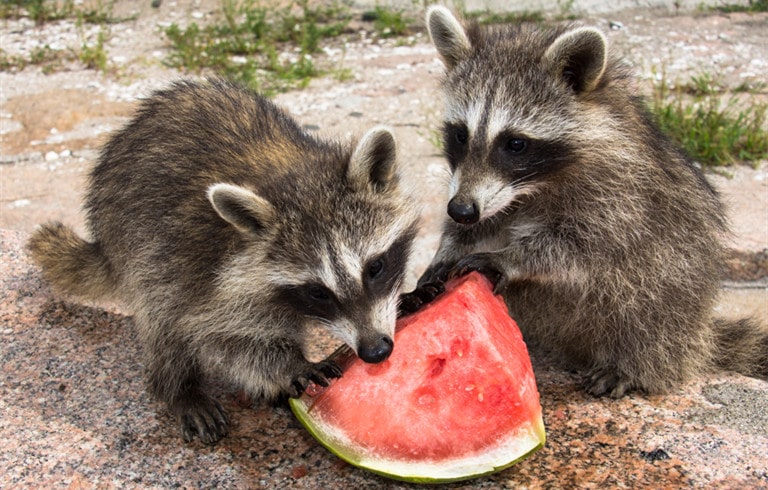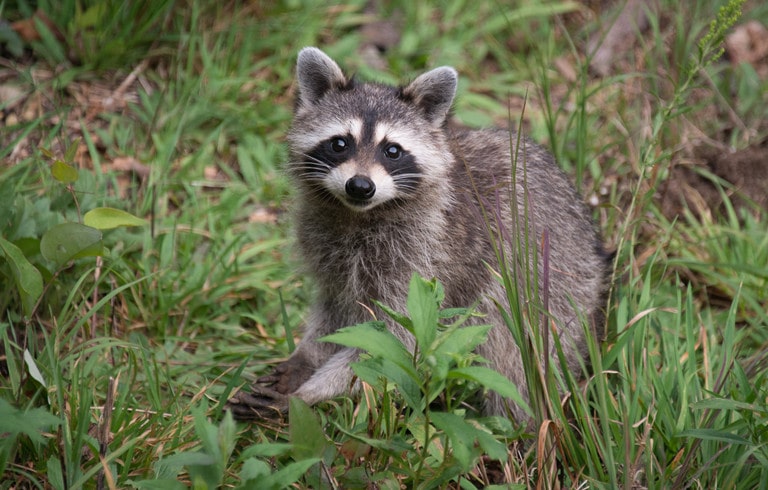Mastering the Art of Raccoon Bait: Strategies and Insights
Discover the intricate world of raccoon baiting, a crucial skill for managing these clever nocturnal visitors. Our guide delves into the best practices, ethical considerations, and alternatives to traditional baiting, providing a comprehensive look at how to interact responsibly with raccoons.
Variety of Raccoon Baits That Work

1. Fresh Fruits & Vegetables
Fresh fruits and vegetables are a natural and effective choice for raccoon bait due to their strong aromas and sweet tastes. Raccoons are particularly drawn to items like watermelon, berries, apples, and grapes. Vegetables such as sweet corn, carrots, and melons can also be appealing. These baits are especially useful in residential areas or near gardens where raccoons are accustomed to finding these foods.
When using fruits and vegetables, it’s important to use them at the right level of ripeness: not too ripe to avoid quick spoilage, but ripe enough to emit a strong and enticing scent. This type of bait is also environmentally friendly and less likely to attract unwanted pests or predators.
2. Sweet Corn and Marshmallows
Sweet corn and marshmallows are a highly effective combination for raccoons, appealing to their love for sugary foods. Marshmallows are particularly useful due to their soft texture and strong scent, which raccoons find irresistible. This bait is ideal for urban settings where raccoons are accustomed to scavenging sweet food remnants.
3. Cooked Fatty Meats
Cooked fatty meats, such as bacon or ham, are excellent for attracting raccoons due to their strong aroma and high-fat content. Raccoons, being omnivores, are naturally drawn to the scent of cooked meats. This type of bait is particularly effective in wooded or rural areas, where raccoons are more inclined towards protein-rich foods.
4. Fish and Shellfish
Fish and shellfish, especially oily varieties like sardines or mackerel, work well as raccoon bait. Their pungent smell can attract raccoons from a considerable distance. This bait is especially useful near water sources or in coastal areas where raccoons are familiar with fishing for their food.
5. Cat Food
Cat food, both wet and dry, is a reliable bait for raccoons due to its strong odor and palatable taste. It’s readily available and convenient to use. This type of bait is versatile, attracting raccoons in various environments, and is especially useful in suburban areas where raccoons often encounter pet food.
6. Honey or Molasses
Honey or molasses can be used as a bait or as an additive to other baits to increase their attractiveness. Their sweet, sticky nature not only draws raccoons with its scent but also keeps them engaged with the bait for a longer period. This tactic is particularly effective in combination with other food items like fruits or bread.
7. Fruit Preserves and Jellies
Raccoons are attracted to the sweet and strong aroma of fruit preserves and jellies. These can be spread on bread or crackers to make them more enticing. The stickiness of the preserves keeps raccoons engaged, and their natural sugar content provides a high-energy food source. This bait is particularly effective in both urban and rural settings, as raccoons are often drawn to fruit-bearing trees and gardens.
8. Eggs
Whole or cracked eggs can be an effective bait for raccoons. Their natural curiosity is piqued by the shape and texture of eggs, and the nutritional value makes them a rewarding find. This bait works well in areas where raccoons are accustomed to raiding bird nests or have limited access to protein-rich foods.
9. Peanut Butter
Peanut butter is a versatile and effective bait due to its strong scent and sticky texture. It can be used alone or combined with other baits like fruits or grains to increase its appeal. The high-fat content in peanut butter is particularly attractive to raccoons, making it a great choice for year-round baiting.
10. Leftover Human Food
Leftovers from human meals, especially those rich in fats and sugars, can be compelling for raccoons. Foods like pizza crusts, meat scraps, or pastries can be used effectively as bait. This method taps into raccoons’ tendency to scavenge in urban environments, where they have become accustomed to eating a variety of human foods.
11. Anise Oil
Anise oil, with its strong licorice-like smell, is an unconventional but effective attractant for raccoons. It can be added to other baits to enhance their aroma or used on cotton balls as a lure. This method is useful in trapping scenarios, as the unique scent of anise oil can pique the curiosity of raccoons, drawing them to the trap.
Setting up Bait

1. Selecting the Right Location
Choosing an effective location is crucial for successful raccoon baiting. Look for areas where raccoon activity has been noticed, such as near garbage bins, gardens, or water sources. The location should be safe, away from areas frequented by pets or children. It should also allow for easy monitoring without disturbing the bait or the raccoons. If using a trap, position it along a path the raccoons regularly use.
2. Preparing the Bait
Preparation of the bait can significantly impact its effectiveness. For solid baits like fruits or meats, consider cutting them into pieces to release more scent. If using liquid attractants like honey or fish oil, apply them sparingly to avoid overwhelming and deterring the raccoons. For a combination of baits, layer them to create a more enticing mix.
3. Placement of the Bait
Place the bait in a manner that makes it accessible to raccoons but not other non-target animals. If using a trap, position the bait at the far end to ensure the raccoon fully enters the trap. For open baiting, place the bait in a shallow dish or directly on the ground, depending on what is safe and appropriate for the environment.
4. Camouflaging the Bait
In some situations, especially when using traps, it helps to camouflage the setup to blend with the surroundings. This can be done using natural materials like leaves, branches, or dirt. The goal is to make the bait and trap seem less conspicuous, reducing wariness in raccoons.
5. Monitoring and Adjusting
After setting up the bait, monitor the area regularly to check for raccoon activity and the bait’s condition. If the bait is not attracting raccoons or is being consumed by other animals, consider changing the bait type, location, or both. Regular monitoring also helps in maintaining cleanliness and safety around the baiting area.
6. Timing Considerations
Raccoons are primarily nocturnal, so it’s best to set up the bait in the late afternoon or early evening. This timing increases the chances of attracting raccoons during their active hours and reduces exposure to non-target animals and daytime predators.
By following these detailed steps, you can effectively set up raccoon bait, increasing the likelihood of successful interactions with these adaptable creatures while ensuring safety and environmental responsibility.
Effective Strategies in Raccoon Baiting

1. Understanding Raccoon Behavior and Preferences
Successful baiting starts with a thorough understanding of raccoon behavior and dietary preferences. Observing local raccoon activity can provide insights into their eating habits and preferred food sources. This knowledge helps in selecting the right type of bait and determining the most effective placement and timing for baiting.
2. Strategic Bait Placement
The placement of bait plays a crucial role in its effectiveness. Bait should be positioned in areas of known raccoon activity, such as near den sites, along travel paths, or in areas where they search for food. The goal is to place the bait in a spot that is easily accessible to raccoons but not overly exposed to non-target animals or humans.
3. Timing and Frequency of Baiting
Timing is important in raccoon baiting. Since raccoons are nocturnal, setting out bait in the late afternoon or early evening can be more effective. Additionally, maintaining a regular baiting schedule can help habituate raccoons to the bait site, increasing the chances of consistent visits.
4. Concealment and Protection of Bait
To prevent non-target animals from accessing the bait and to keep the bait fresh, it may be necessary to conceal or protect it. This can be done using bait stations or by covering the bait with natural materials. Concealment also helps in making the baiting set-up less obvious, reducing wariness in raccoons.
5. Adjusting Techniques Based on Results
Baiting strategies may need to be adjusted based on the results observed. If raccoons are not attracted to the bait, or if the wrong animals are being attracted, changing the type of bait, its placement, or the baiting schedule can be necessary. Keeping a log of baiting efforts and outcomes can be helpful in determining the most effective strategies.
6. Safety and Ethical Considerations
It’s important to consider the safety of both wildlife and humans when baiting. This includes using non-toxic baits and ensuring that the baiting does not harm the raccoons or other non-target species. Ethical considerations also involve compliance with local wildlife regulations and respecting the natural behavior of raccoons.
By focusing on these techniques and considerations, this section offers a comprehensive guide to the strategic aspects of baiting raccoons, ensuring effectiveness while maintaining safety and ethical standards.
Alternatives to Baiting

1. Environmental Modifications
Modifying the environment can deter raccoons without the need for bait. This includes securing garbage bins with raccoon-proof lids, removing food sources like pet food or bird feeders, and trimming tree branches that provide access to rooftops or attics. Making the area less hospitable or accessible to raccoons can significantly reduce their presence.
2. Use of Repellents
There are various commercial repellents available that can discourage raccoons from entering an area. These typically use smells or tastes that are unpleasant to raccoons, such as ammonia, vinegar, or predator urine. Natural repellents like hot pepper spray can also be effective. It’s important to regularly reapply these repellents, as their effectiveness can diminish over time, especially outdoors.
3. Physical Barriers
Installing physical barriers is a long-term solution to prevent raccoon intrusion. This can include fencing around gardens, installing grates over chimneys, or using wire mesh to block entry points to buildings. The barriers should be sturdy and properly installed to ensure they are effective against the strength and dexterity of raccoons.
4. Ultrasonic Devices and Motion-Activated Lights
Ultrasonic devices emit high-frequency sounds that are irritating to raccoons but inaudible to humans. Similarly, motion-activated lights can startle and deter raccoons when they enter a certain area. These methods can be effective, especially in combination, as they create an uncomfortable environment for raccoons without causing harm.
5. Habitat Modification
Reducing the attractiveness of the environment to raccoons can be a proactive approach. This includes clearing brush piles or dense shrubbery where raccoons might nest, and ensuring that water sources like ponds or pools are not easily accessible. A clean and well-maintained yard is generally less appealing to raccoons looking for food or shelter.
6. Encouraging Natural Predators
While not a direct method, encouraging the presence of natural predators can help control raccoon populations. This can include creating habitats for birds of prey or ensuring that natural ecosystems in the area are balanced and healthy. However, this approach requires careful consideration of the overall ecological impact.
These alternatives to baiting offer a range of options for managing raccoon presence. They can be more sustainable and environmentally friendly, focusing on prevention and deterrence rather than attraction. Combining several of these methods can often provide the most effective solution to raccoon issues.
Conclusion
This article provides a thorough understanding of raccoon bait and its responsible use. We encourage readers to approach raccoon management with respect for wildlife and the environment.






